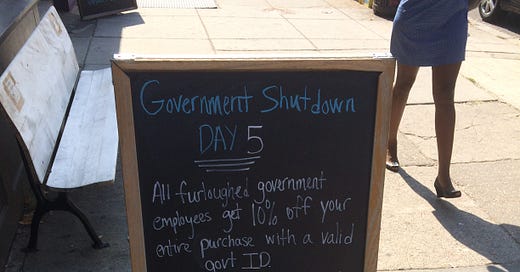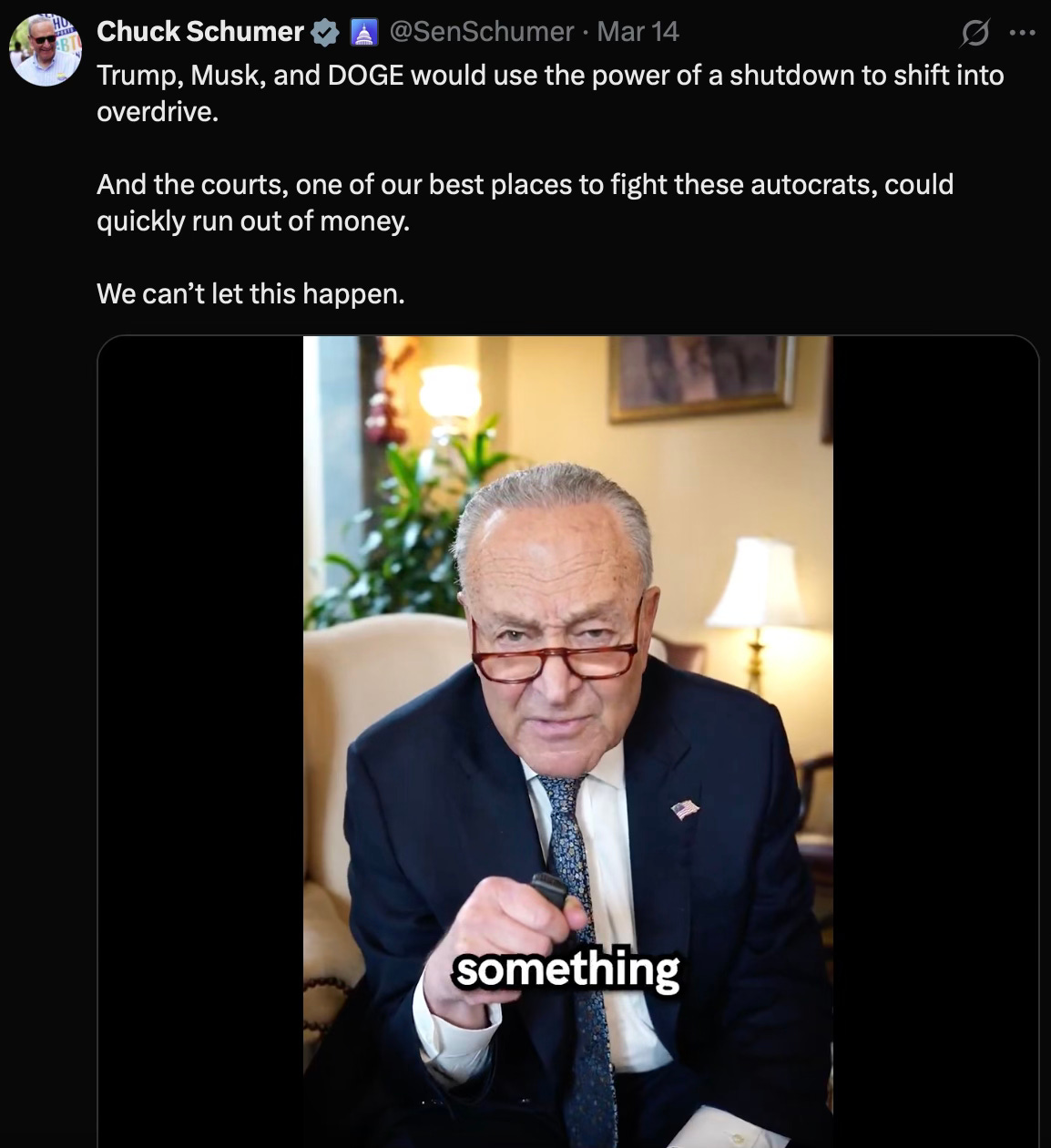Why America didn’t need a shutdown showdown
The federal government didn’t shut down on Friday – and that’s a good thing. While some say Democrats showed weakness or caved, a better discussion is what Democrats want to do when they regain power
The government could have shut down at the end of last week. Senate Democrats could have stood in the way of a continuing resolution supported by the White House, that some in Congress believed was a power grab. Democrats could have used Senate procedures to block it.
But they didn’t.
In the aftermath, most of the debate and chatter has swirled around power. Some say Democrats should have forced a shutdown, exerting their limited power to try to and check President Trump or Republicans in Congress. Senate Minority Leader Chuck Schumer (D-New York) proved a decisive vote, and has come in for withering criticism for not using his power.
Schumer, for his part, said he didn’t want to give more power to President Trump and DOGE through a government shutdown that would given the executive branch, during the shutdown, absolute power.
Schumer and nine other Democrats in the Senate voted to keep the government open.
As someone who has worked through a government shutdown in the White House, and seen the absolute power of the executive branch to determine what is and what is not essential, Schumer had a point. A shutdown would empower Trump’s team and give Congress less oversight at a critical time. At the same time, it would prove punishing to many important constituencies.
But Democrats, while they’re debating who should use what power, are also missing a critical opportunity to talk instead about what they would do with power for the American people. And as they strive to regain power, that will have to change.
Inside a shutdown
It was October 2013 when I experienced first-hand a government shutdown from the executive branch. I was working in the White House when Republicans had gained power in 2010, with the Tea Party movement leading the way, demanding more “fiscal responsibility.”
For a few years, a shutdown threat loomed. Each time government funding was in question key Republicans would withhold their votes (sometimes without clear objectives). Negotiations were tense, and ultimately each time some responsible contingent would keep the government operational. Until it didn’t. The October 2013 shutdown was the third longest in history.
We had been gearing up for an international trip for President Obama to attend the Asia-Pacific Economic Cooperation Leaders Meeting in Indonesia, and meetings in Brunei and Malaysia. The administration had been working on a regional trade deal that would, negotiators argued, isolate China’s bad practices.
Because I was key in planning the trip and coordinating with press outlets, I stayed on initially during the government shut down.
We even tried to do an area trip to take the President outside of the White House, to Maryland, to show the effects of a government shutdown. What many forget is these shutdowns have real effects on our small businesses (the small business administration shuts down loans, and some contracts are delayed), on childcare (some Head Start centers and other child care facilities close), on Americans’ pocketbooks (the IRS among other agencies shuts down operations). We were hoping to remind Americans and Congressional leaders of the dire consequences.
The outing from the White House proved very difficult to pull off with only a few of us deemed essential. The negotiations largely were unchanged. And we ended up pulling down the trip to Asia, which was frustrating to all, as it was seen as key to countering China.
Had we been more aggressive with executive power, it might have been possible that more people could have been deemed essential (they would work without the promise of pay). I am pretty sure that Trump would have taken this approach with his core team, responsible for executing many of the policies and decisions that Democrats are complaining about at the moment.
But if the shutdown I worked through is precedent — the White House would have determined much of what stayed open, and the effect would have been more chaos for the American people. And unfortunate for those in need, because like what we’ve seen with reckless cuts from DOGE, it can have an axe-like effect.
It’s perhaps why so many Democrats said then it was reckless, and why key Democrats opted against a government shutdown this time.
Biden’s Budget Continuation
The Resolution passed Friday night that averted a government shutdown essentially keeps the Biden negotiated budget until September. (California’s Gov. Gavin Newsom made that point recently on his podcast with Steve Bannon.)
The CR, as it is known, has a few tweaks — increased defense spending, decreased non-defense spending, the White House Office of Management and Budget gained more discretion in moving funds around and, ironically given the Republican-led shutdown I lived through, removed a requirement to offset deficit spending. It postponed Medicaid changes and changes to drug enforcement.
Senate Democrats who voted to keep the government open include Pennsylvania’s John Fetterman, New York’s Kirsten Gillibrand, and Illinois’ Dick Durbin.
Rep. Alexandria Ocasio-Cortez (D-NY) argued last week Senate Democrats were reckless, saying Democrats should have forced the House to come back by withholding their votes, forcing a 30-day extension to continue negotiations. There were many in the Democratic party cheering her on, frustrated with those who sided with the White House and Republicans in Congress.
I listened to the whole of the interview with Ocasio-Cortez and she made the point she didn’t want to see cuts to Medicaid, Medicare, Social Security, she didn’t want cuts to education, she didn’t want increases to defense spending, and didn’t want the Trump tax cuts that will unbalance any budget. She made many points that Democrats, including those who backed the bill, would agree to. But the focus on infighting and power distracted from the end game.
Democrats need to stop talking about what they *don’t* want to see, and start talking about what they *do* want to see.
I kept thinking — with all this oxygen, where’s the broader vision for the Democratic party? What’s the “Project 2029” that will rebuild institutions and America for a robust middle class? Is there a service component as Secretary Pete Buttigieg and Maryland Governor Wes Moore have talked about? Is there a guaranteed education-to career path opportunities that can lead to real living wages for Americans throughout the country?
What’s the path to clean water, food resources, and housing that’s affordable for all Americans?
What does America’s next generation national security look like – in a cyber world and increasingly satellite dependent world – what is the plan to regulate and hold accountable bad actors?
And how do we stop talking about marginal measures on healthcare and actually push plans that provide healthcare to every American?
For now, with this debate, there’s none of these things. Just infighting.

Vision ahead
There is an opportunity in reshuffling for Democratic leaders to lay out a vision that can be more inclusive, more balanced, ensure proper regulation and allow innovation. This fight, though — over what’s essentially Biden’s budget with Republican tweaks — is a distraction from that. They have work to do.
I suppose that’s maybe why House Minority Leader Hakeem Jeffries refused questions about the infighting or the Senate Minority Leader’s position. “Next question,” he said.
In the end there will be another debate — this CR only goes until September — and it sure would be good if some of those Democrats in Congress with strong opinions started working together on efforts for a vision that could give them real power.






